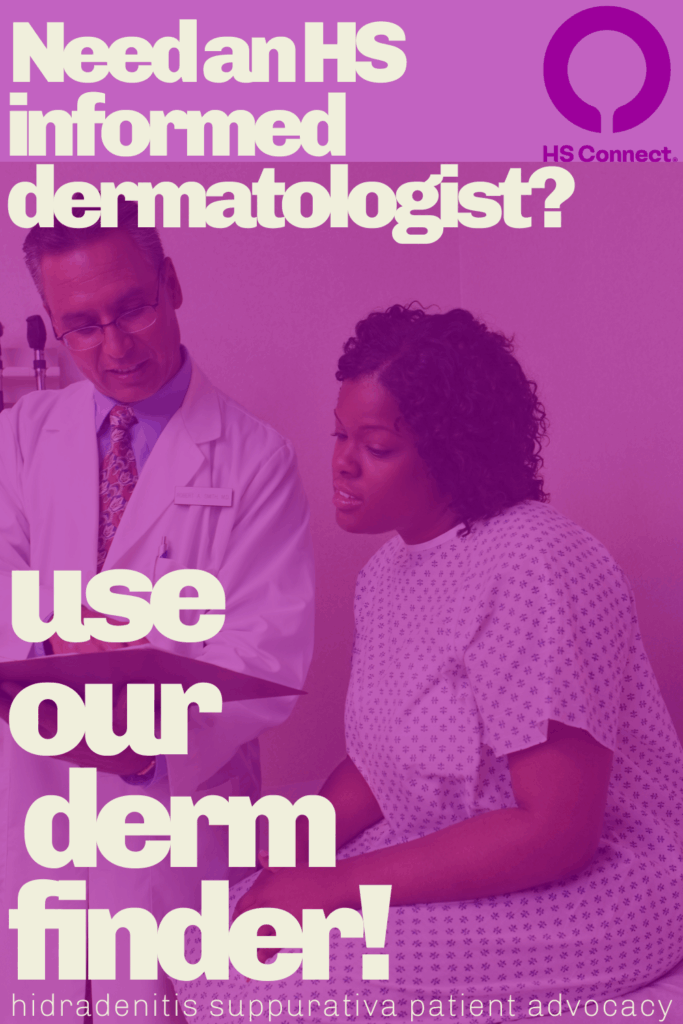By: Eriel Lauffer
Living—and working—with Hidradenitis Suppurativa (HS) can feel like juggling flaming bowling pins on a unicycle. Some days you nail the act; other days a flare knocks you right off the stage. If HS has made it impossible to stay in the workforce, federal disability benefits can keep the lights on while you focus on healing. But the Social Security Administration (SSA) paperwork? Whew—talk about a plot twist.
Take a deep breath. We’ve built this guide from top to bottom to help you cruise through the red tape with fewer detours, fewer headaches, and a lot more confidence. You’ll learn exactly how to:
- Decide whether SSDI, SSI, or both programs fit your situation
- Organize medical evidence so your HS story is impossible to ignore
- Avoid the most common application mistakes that trigger fast rejections
- Lean on advocates—doctors, lawyers, friends—without breaking the bank
Bookmark this page, pour your beverage of choice, and let’s get to work.

Quick Primer: SSDI vs. SSI (and Why You Might Qualify for Both)
When people say they’re “on disability,” they’re usually talking about one of two federal programs. Understanding the difference helps you target the right paperwork and avoid months of limbo.
1. Social Security Disability Insurance (SSDI)
- What it is: An insurance program you’ve been paying into through your payroll taxes (those FICA deductions).
- Who qualifies: Workers who have earned enough “credits” based on age and recent employment.
- Why HS patients apply: If HS lesions, chronic infections, and associated pain have forced you out of the workforce, SSDI replaces a portion of the paycheck you lost.
Minimum Work-Credit Cheat Sheet
| Age when disability started | Credits needed | How many years of work is that?* |
| Under 24 | 6 credits | ≈ 1.5 years |
| 24–31 | 12 credits | ≈ 3 years |
| 31+ | 20 credits in the 10 years before disability | ≈ 5 years |
*One credit = roughly $1,800 in earnings in 2025. Four credits max per calendar year.
2. Supplemental Security Income (SSI)
- What it is: A needs-based safety net funded from general tax revenue—no work history required.
- Who qualifies: Adults (or children) with limited income and resources and a qualifying disability.
- Why HS patients apply: If flare-ups have sidelined you before you built a solid work record, or if your household income is low, SSI can keep food on the table and provide Medicaid coverage.
Pro tip: You can apply for SSDI and SSI at the same time. If approved for both, SSI may “top up” a small SSDI check.
Does the SSA Recognize Hidradenitis Suppurativa as a Disability?
Yes—HS has its own listing in the SSA Blue Book (Section 8.06, “Hidradenitis Suppurativa”). That means the agency already agrees HS can be disabling. Your job is to prove it’s disabling for you.
Blue Book Requirements (The Fast-Track Route)
To win under Listing 8.06, you must document:
- Extensive skin lesions with inflammatory nodules or sinus tracts, located in both armpits, both groins, or the perineum, and
- Persistence for at least three months despite continuing medical care.
Meet both criteria on paper, and the SSA should approve without extra hoops. Fall a little short? Don’t panic—you still have options via medical-vocational rules (more on that shortly).
Building a Rock-Solid HS Disability File
1. Medical Evidence That Speaks Louder Than Words
Your file needs to show HS, not just say you have it. Gather:
- Dermatology notes: Diagnosis date, Hurley stage, treatments tried (antibiotics, biologics, surgery), side effects, wound-care instructions.
- Primary-care and specialist records: Document comorbidities (cellulitis, depression, anemia, Crohn’s-like fistulas).
- Surgical & ER reports: Incision and drainage procedures, hospital stays, high fevers, IV antibiotics.
- Prescription logs: Dates and dosages of adalimumab, infliximab, or other biologics that demonstrate aggressive treatment.
- Photo diary: Timestamped images of flare-ups every few weeks. Use your phone; back up to the cloud.
- Work limitation statements: Ask your clinician to complete an RFC (Residual Functional Capacity) form explaining why standing, lifting, sitting, or even typing exacerbates your pain.

2. Personal Evidence the SSA Rarely Sees—but Should
- Symptom journal: Track pain levels, drainage, dressing changes, and missed activities.
- Employer notes: Performance write-ups, reduced hours, attendance warnings.
- Family & friend affidavits: Short letters describing how they help with wound care, mobility, or daily tasks.
3. Financial Proof for SSI
- Two months of bank statements
- Current lease or mortgage coupon
- Utility bills
- Vehicle registration and current market value (Kelley Blue Book printout)
- Life-insurance cash value statements
What If You Don’t Meet the Blue Book Listing?
Most HS applicants don’t hit every bullet of Listing 8.06—especially if lesions rotate between sites or treatment occasionally calms them down. That’s where medical-vocational (“grid”) rules and equivalency listings step in.
Medical-Vocational (Grid) Rules
The SSA considers:
- Age: The older you are, the easier the grid.
- Education: Limited schooling can strengthen your claim.
- Past work: If your previous job required physical labor or constant public contact (hard with odors or drainage), you may qualify even with fewer medical boxes checked.
Equivalency Listings You Can Leverage
- Listing 8.04 – Chronic Infections (Cellulitis): Frequent bacterial infections due to HS tunnels.
- Listing 5.06 – Inflammatory Bowel Disease: If HS fistulas extend internally, mimicking Crohn’s.
- Listing 14.08 – Immune Deficiency: Recurrent systemic infections.
A skilled disability lawyer or representative can map your records to the best alternative.
Step-by-Step: How to File Your HS Disability Claim
- Create a My Social Security account at SSA.gov.
- Complete the Adult Disability Report online (or on paper with Form SSA-3368).
- Upload/attach your medical evidence—as much as the portal allows.
- Sign the medical-release form (SSA-827) so the SSA can request records you missed.
- Submit the SSI application if your income/assets are below your state’s threshold.
- Mail or fax any oversized files (photos, journal pages) not accepted online; include your SSN on every page.
- Save or screenshot your confirmation number—it’s your proof of filing.
Heads-up: A continuing disability review (CDR) happens every 3–7 years. Keep up your treatment plan and records even after approval.
Common HS Disability Roadblocks (and How to Dodge Them)
| Roadblock | Why It Happens | Your Fix |
| Mislabeling HS as “autoimmune” | Reviewers look in the wrong Blue Book section. | Always call HS a “chronic inflammatory skin disorder.” |
| Sparse treatment history | Gaps suggest the condition isn’t severe. | Schedule regular derm visits—even telehealth counts. |
| No proof symptoms last 12+ months | SSA needs duration evidence. | Provide a timeline with flare dates and doctor visits. |
| Ignoring mental-health impacts | Depression/anxiety often elevate severity but go undocumented. | Ask your PCP for a mental-health referral and include therapy notes. |
| Missing SSA appointments | Automatic denial for “non-cooperation.” | Put reminders on your phone; reschedule if you’re truly stuck. |
Should You Hire a Disability Lawyer?
We’re pro-empowerment here at HS Connect, so the choice is yours. But know this:
- Attorneys work on contingency (typically 25% of back pay, capped by law).
- They front most costs, gather missing records, and prep you for the hearing.
- Approval odds jump from about 34% at initial filing to 60%+ at hearing—and legal reps drive many of those wins.
If paperwork overwhelms you or your first attempt tanked, a lawyer can be a game-changer.
Tools, Resources & Free Training
- SSA Disability Starter Kits – Checklists and sample forms straight from the agency.
- Benefits Planner – Estimate your monthly SSDI amount and SSI eligibility.
- SOAR (SSI/SSDI Outreach, Access, and Recovery) – Free online course teaching advocates how to complete disability applications for people with complex conditions.
- Office of Disability Employment Policy (ODEP) – Guidance on workplace accommodations if you’re still employed.
- HS Connect Community – Peer advice, flare-friendly job ideas, and moral support 24/7.

Key Takeaways (TL;DR … But Actually Read 😜)
- HS is officially disabling in the SSA’s eyes—Listing 8.06 is your north star.
- Detailed, dated medical evidence turns “maybe” into “approved.”
- Work-credit math matters for SSDI; income limits matter for SSI.
- Alternative listings and grid rules rescue claims that don’t fit the textbook.
- Organization + persistence + (optional) legal backup = your best shot at benefits and breathing room.
You’ve got enough on your plate wrangling flares, dressings, and daily life. Let this guide shave months off the disability maze so you can focus on healing—not haggling with paperwork.
Medical Disclaimer
The information provided by HS Connect (“we,” “us,” or “our”) on this website HSConnect.org] (the “Website”) is for general informational purposes only. All content, including text, graphics, images, and information, is presented as an educational resource and is not intended as a substitute for professional medical advice, diagnosis, or treatment.
Please consult with a qualified healthcare provider before making any decisions or taking any action based on the information you find on this Website. Do not disregard, avoid, or delay obtaining medical or health-related advice from your healthcare provider because of something you have read on this Website.
This Website does not recommend or endorse any specific tests, physicians, products, procedures, opinions, or other information that may be mentioned on this website. Reliance on any information provided on the Website, its content creators, or others appearing on the website is solely at your own risk.
If you think you may have a medical emergency, call your doctor, go to the nearest emergency department, or call emergency services immediately. We are not responsible for any adverse effects resulting from your use of or reliance on any information or content on this Website.
By using this Website, you acknowledge and agree to this disclaimer in full.
